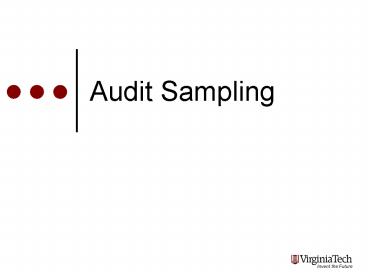Audit Sampling - PowerPoint PPT Presentation
1 / 12
Title:
Audit Sampling
Description:
... Credit is approved, Details on bill of lading agree to sales invoice, Pricing ... Agreement of details on bill of lading and sales invoice ... – PowerPoint PPT presentation
Number of Views:73
Avg rating:3.0/5.0
Title: Audit Sampling
1
Audit Sampling
2
Risks of Sampling
- Sampling Risk
- The risk that an auditor will reach an erroneous
conclusion because the sample was not
representative - Nonsampling Risk
- The risk that audit tests will not uncover
exceptions
3
Sampling Risk
- Efficiency
- Risk of assessing control risk too high
- Risk of incorrect rejection
- Effectiveness
- Risk of assessing control risk too low
- Risk of incorrect acceptance
- These must be considered when planning a sample
4
Sample Selection
- Two basic techniques
- Probabilistic
- Nonprobabilistic
- Probabilistic selection allows auditors to
quantify sampling risk, while nonprobabilistic
does not.
- Probabilistic
- Random
- Probability proportional to size
- Stratified random
- Nonprobabilistic
- Judgmental
- Directed
- Block
5
Planning Samples
- Substantive tests
- Relationship of the sample to the audit objective
- Tolerable misstatement (inverse)
- Risk of incorrect acceptance (inverse)
- Tests of controls
- Relationship of the sample to the audit objective
- Tolerable deviation rate (inverse)
- Risk of assessing control risk too low (inverse)
- Likely rate of deviations (direct)
6
Steps in Audit Sampling
- State the objectives of the test
- Decide whether audit sampling is appropriate
- Define attributes and exception conditions
- Define the population
- Define the sampling unit
- Specify the TER and the ARACR
- Estimate the EPER
- Determine the initial sample size
7
Steps in Audit Sampling
- Determine the selection method and select the
sample - Perform the audit procedures (e.g., TOC)
- Evaluate the results based on
- SDR
- Sample size
- ARACR
- Qualitative aspects of deviations
- Decide acceptability of the population
8
Attributes Sampling
- Attributes sampling is the most common sampling
method used for tests of controls (TOC) - Attributes sampling is applied whenever the
population contains characteristics of interest - Examples Credit is approved, Details on bill of
lading agree to sales invoice, Pricing and
extensions on invoices are checked, etc. - Attributes sampling may follow either a
statistical sampling or a non-statistical
sampling methodology
9
Attribute Sampling Example
- Facts
- You wish to conduct TOC related to a clients
sales and receipts cycle. - You are specifically interested in testing
controls related to the shipping and invoicing
processes. - You decide to test the following attributes
- Credit approval
- Agreement of details on bill of lading and sales
invoice - Verification of pricing and extensions on
invoices - You will select a sample from duplicate sales
invoices
10
Attribute Sampling Example
- Facts (cont.)
- TDR is 5
- ARACR is 5
- EPER is 0.50
- You selected your sample using a simple random
selection technique where the invoice numbers
were used to select the items
11
Attribute Sampling Example
- Determine the sample size
- Initial sample size __________
- Your results were
- Observed deviations 2
- No significant qualitative issues were observed
- Sample and population evaluation
- TDR 5
- Computed (Achieved) Upper Precision Limit ____
- Decision ________________________________
12
Evaluation of Results
- Considerations related to substantive tests
- Calculate the allowance for sampling risk
- Nature of misstatements
- Relationship of misstatements to other aspects of
the audit - Possible fraud
- Considerations related to tests of controls
- Inability to apply tests is indicative of a
deviation - Calculate the allowance for sampling risk
- Relationship of exceptions to other aspects of
the audit - Possible fraud































